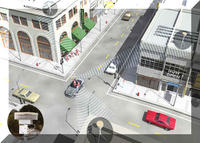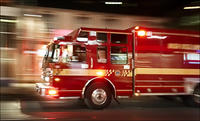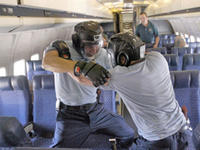-
Turkish PM criticizes builders for unsafe practices
Sunday’s 7.2 tremor in Turkey killed at least 460 people, injured 1,350, destroyed more than 2,000 buildings, and displaced thousands; Turkish prime minister harshly criticizes Turkish builders, saying negligence amounts to murder
-
-
Turkish prisoners riot following aftershock, quake death toll now 432
After a particularly strong aftershock rattled Turkey, terrified Turkish prisoners rioted after authorities refused to let them out
-
-
Illinois distributes $3.4 million to help first responders upgrade radios

Earlier this week the Illinois Terrorism Task Force (ITTF) announced that it was awarding more than $3.4 million to 156 local emergency response agencies across the state to upgrade their communications equipment; the funds come from DHS grants designed to help states comply with new federal communications requirements aimed at relieving congestion and increasing channels on non-narrowband radios
-
-
ShotSpotter, Intrado join acoustic surveillance, 9-1-1 service

ShotSpotter, Inc. and Intrado Inc. today announced the expansion of their partnership in delivering real-time acoustic surveillance and gunfire location alert and analysis services to public safety agencies. Intrado, a provider of 9-1-1 technology solutions, will host the ShotSpotter solution using its secure Intrado Co-location and Transport cloud service (I-CAT). ShotSpotter offers gunfire alert and analysis technology as a subscription-based service.
-
-
Graduate student develops emergency communication Twitter app
A graduate student at the University of Colorado has developed a smartphone app that makes it easier for first responders and emergency personnel to communicate via Twitter during disasters; without a standardized syntax, emergency personnel, affected individuals, information officers, and journalists were having trouble communicating on Twitter
-
-
Predicting race and ethnicity from irises now possible

Conventional wisdom holds that irises, like fingerprints, are unique to each individual and have little similarities between ethnic groups or gender, but a groundbreaking new study indicates that biometric scanners can actually predict race and gender based on iris texture alone; the study’s findings are important in that it opens new avenues for research that previously were not thought possible
-
-
Security professionals gear up for GovSec West
Security professionals from across the country are slated to descend upon Phoenix, Arizona for the GovSec West security conference in November; attendees will have the opportunity to participate in educational sessions that focus on securing critical infrastructure, cyber threats, terrorism, and border security
-
-
Denver holds Operation Mountain Guardian drill
The city of Denver, Colorado plays host to a massive terror-attack simulation involving over 100 emergency services organizations; the largest drill of its kind in the region is intended to ‘stress-test” the planning and resources of local first responders
-
-
Saving victims trapped under concrete
New tool allow first responders to reach those trapped beneath concrete more quickly; the tool generates a high-energy jolt to create a contained hole in the concrete; a series of these holes allows the creation of an area large enough to deliver vital supplies such as food, water, and medicine to victims before first responders are able to get victims to safety.
-
-
Emergency communication remains a challenge ten years after 9/11
Chris Russo, a twenty-five year firefighting veteran, a 9/11 first responder, and the founder of ELERTS Corporation, discusses the challenges first responders face in communicating with each other in major disasters, the lack of progress made to create an inter-operable system for emergency responders, and how technology is changing how authorities communicate and interact with the public during major disasters
-
-
Law enforcement still unable to communicate ten years after 9/11

Ten years after the 9/11 attacks, emergency responders from varying agencies still lack the communications tools to effectively communicate with one another; during the chaos of the 9/11 attacks, emergency responders had difficulty communicating and the 9/11 Commission recommended that a nationwide broadband network be created for emergency responders, but ten years later, according to the Commission’s ten year report card, this nationwide network “continues to languish”
-
-
D.C. continues to struggle with orderly evacuations

Last week’s earthquake that struck less than ninety miles outside of Washington, D.C. exposed the city’s continuing difficulties in effectively evacuating its residents; after the 5.9 magnitude earthquake struck the region, commuters were left stranded for hours as road traffic ground to a halt and trains became overcrowded and delayed due to speed restrictions because of the quake
-
-
New training facility features simulated bus, air, and rail stations

On Tuesday DHS Secretary Janet Napolitano was in Brunswick, Georgia for the grand opening of a sophisticated new $5.3 million counter-terrorism training center for law enforcement officials; the 22,000 square-foot facility features several simulation areas including a mock bus terminal, subway station, and an airport terminal
-
-
Quake disrupts East Coast cell service

Tuesday’s 5.9 magnitude earthquake that struck Virginia and could be felt across the northeast, exposed continuing weaknesses in U.S. emergency communications networks; residents in the northeast experienced difficulty making calls on their cell phones, despite no reported damage to communications infrastructure
-
-
Water mist puts out fires at low pressure
A new water mist system allows for fires to be extinguished from a distance of eight meters; the system’s special nozzles generate a fine mist of tiny water droplets; the water and the propellant nitrogen are non-hazardous, environmentally friendly, and leave no residues
-
More headlines
The long view
Using Drone Swarms to Fight Forest Fires
Forest fires are becoming increasingly catastrophic across the world, accelerated by climate change. Researchers are using multiple swarms of drones to tackle natural disasters like forest fires.
